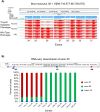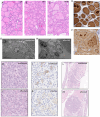LINE-1 transposition into murine Thyroglobulin results in congenital thyroid dysplasia
- PMID: 40627674
- PMCID: PMC12237065
- DOI: 10.1371/journal.pone.0325493
LINE-1 transposition into murine Thyroglobulin results in congenital thyroid dysplasia
Abstract
A spontaneous mutation in the wild type C57BL/6NTac mouse was discovered that is associated with early-onset histopathologic sequalae typical of thyroid dysplasia. The spontaneous mutation resulted from insertion of a L1 long interspersed nuclear element (LINE-1) into an intron within the Thyroglobulin (Tg) gene. The mouse genome contains a significant amount of retrotransposon DNA, and these mobile genetic elements routinely change genomic location through retrotransposition, including in germ cells. Analysis of the thyroid transcriptome suggested that the presence of the LINE-1 interferes with the Tg gene splicing, resulting in exclusion of exon 26 from most Tg transcripts in animals homozygous (HOM) for the insertion. The LINE-1 insertion allele of the Tg gene has been designated Tgtdys-Tac. The resulting phenotype is inherited in an autosomal dominant manner with affected mice exhibiting thyroid follicular cell dysplasia that progresses to thyroid adenoma by 9 months of age with complete penetrance in homozygotes. Serum thyroid hormone measurements revealed a decrease in triiodothyronine (T3) levels in homozygotes at 12 months of age, as well as a decrease in tetraiodothyronine (T4) levels at 6-9 months and at 12 months of age in both heterozygotes and homozygotes. In addition, serum Thyroid Stimulating Hormone (TSH) level was strongly increased in homozygotes at 6-8 months of age, consistent with hypothyroidism. Computational molecular modeling showed that omission of the 64 amino acids from the TG protein arm domain, which is the consequence of exon 26-skipping in the Tg transcript, results in decreased local stability. This result in combination with the observed up-regulation in unfolded protein response (UPR) pathways in the thyroids of affected animals, identifies the arm domain of TG as important for its proper cellular distribution. This report describes a spontaneous retrotransposon insertion causatively linked to dysregulated physiological phenotypes in a widely used inbred mouse strain.
Copyright: © 2025 Bailey et al. This is an open access article distributed under the terms of the Creative Commons Attribution License, which permits unrestricted use, distribution, and reproduction in any medium, provided the original author and source are credited.
Conflict of interest statement
The authors have declared that no competing interests exist.
Figures






References
MeSH terms
Substances
LinkOut - more resources
Full Text Sources
Molecular Biology Databases
Miscellaneous

